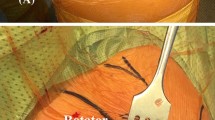Abstract
Introduction
Some of the most important causes of shoulder pain are inflammation and degenerative changes in the rotator cuff (RC). Magnetic resonance imaging (MRI) is a noninvasive and safe imaging modality. MRI can be used for the evaluation of cuff tendinopathy. In this study, we evaluated the relationship between glenoid cavity depth and cuff tendinopathy and we investigated glenoid cavity depth on the pathogenesis of cuff tendinopathy.
Materials and methods
We retrospectively evaluated 215 patients who underwent MRI. Of these, 60 patients showed cuff tendinopathy (group A) and 54 patients showed no pathology (group B). Glenoid cavity depth was calculated in the coronal and transverse planes.
Results
The mean axial depth was 1.7 ± 0.9 and the mean coronal depth 3.8 ± 0.9, for group A. The mean axial depth was 3.5 ± 0.7 and the mean coronal depth 1.5 ± 0.8, for group B. There were significant differences in the axial and coronal depths between the two groups.
Conclusion
High coronal and low axial depth of the glenoid cavity can be used to diagnose RC tendinitis.


Similar content being viewed by others
References
Tekavec E, Joud A, Rittner R, Mikoczy Z, Nordander C, Petersson IF et al (2012) Population-based consultation patterns in patients with shoulder pain diagnoses. BMC Musculoskelet Disord 13:238
Hanratty CE, McVeigh JG, Kerr DP, Basford JR, Finch MB, Pendleton A et al (2012) The effectiveness of physiotherapy exercises in subacromial impingement syndrome: a systematic review and meta-analysis. Semin Arthritis Rheum 42:297–316
Seitz AL, McClure PW, Finucane S, Boardman ND 3rd, Michener LA (2011) Mechanisms of rotator cuff tendinopathy: intrinsic, extrinsic, or both? Clin Biomech (Bristol, Avon) 26:1–12
Neer CS 2nd (1972) Anterior acromioplasty for the chronic impingement syndrome in the shoulder: a preliminary report. J Bone Joint Surg Am 54:41–50
Sein ML, Walton J, Linklater J, Harris C, Dugal T, Appleyard R et al (2007) Reliability of MRI assessment of supraspinatus tendinopathy. Br J Sports Med 41:e9
Churchill RS, Brems JJ, Kotschi H (2001) Glenoid size, inclination, and version: an anatomic study. J Shoulder Elbow Surg 10:327–332
Schulz CU, Anetzberger H, Glaser C (2005) Coracoid tip position on frontal radiographs of the shoulder: a predictor of common shoulder pathologies? Br J Radiol 78:1005–1008
De Wilde L, Defoort S, Verstraeten TR, Speeckaert W, Debeer P (2012) A 3D-CT scan study of the humeral and glenoid planes in 150 normal shoulders. Surg Radiol Anat 34:743–750
De Wilde LF, Berghs BM, VandeVyver F, Schepens A, Verdonk RC (2003) Glenohumeral relationship in the transverse plane of the body. J Shoulder Elbow Surg 12:260–267
Kebaetse M, McClure P, Pratt NE (1999) Thoracic position effect on shoulder range of motion, strength, and three-dimensional scapular kinematics. Arch Phys Med Rehabil 80:945–950
Middernacht B, de Grave PW, Maele GV, Favard L, Molé D, De Wilde L (2011) What do standard radiography and clinical examination tell about the shoulder with cuff tear arthropathy? J Orthop Surg Res 6:1
Stoller DW, Wolf EM, Li AE et al (2007) Shoulder. In: Stoller DW (ed) Magnetic resonance imaging in orthopaedics and sports medicine. Lippincott Wiliams & Wilkins, Baltimore, pp 1131–1463
Palmer WE, Brown JH, Rosenthal DI (1994) Labral-ligamentous complex of the shoulder: evaluation with MR arthrography. Radiology 190:645–651
Schmid MR, Hodler J (2001) MRT und MR arthrographie. In: Habermeyer P (ed) Schulterchirurgie. Munchen Jena, Urban & Fischer, pp 103–126
Zanetti M, Gerber C, Hodler J (1998) Quantitative assessment of the muscles of the rotator cuff with magnetic resonance imaging. Invest Radiol 33:163–170
Bianchi S, Martinoli C (2007) Ultrasound of the musculoskeletal system: sholuder, vol 190. Springer-Verlag, Berlin, p e331
Rutten MJ, Jager GJ, Blickman JG (2006) US of the rotator cuff: pitfalls, limitations and artefacts. Radiographics 26:589–604
Tuite MJ (2012) Magnetic resonance imaging of rotator cuff disease and external impingement. Magn Reson Imaging Clin N Am 20:187–200
Ly JQ, Beall DP, Sanders TG (2003) MR imaging of glenohumeral instability. AJR Am J Roentgenol 181:203–213
Brewer BJ, Wubben RC, Carrera GF (1986) Excessive retroversion of the glenoid cavity. A cause of non-traumatic posterior instability of the shoulder. J Bone Joint Surg Am 68:724–731
De Wilde LF, Verstraeten T, Speeckaert W, Karelse A (2010) Reliability of the glenoid plane. J Shoulder Elbow Surg 19:414–422
Bishop JL, Kline SK, Aalderink KJ, Zauel R, Bey MJ (2009) Glenoid inclination: in vivo measures in rotator cuff tear patients and associations with superior glenohumeral joint translation. J Shoulder Elbow Surg 18:231–236
Yamaguchi K, Ditsios K, Middleton WD, Hildebolt CF, Galatz LM, Teefey SA (2006) The demographic and morphological features of rotator cuff disease. A comparison of asymptomatic and symptomatic shoulders. J Bone Joint Surg Am 88:1699–1704
Saha AK (1971) Dynamic stability of the glenohumeral joint. Acta Orthop Scand 42:491–505
McPherson EJ, Friedman RJ, An YH, Chokesi R, Dooley RL (1997) Anthropometric study of normal glenohumeral relationships. J Shoulder Elbow Surg 6:105–112
Author information
Authors and Affiliations
Corresponding author
Ethics declarations
Conflict of interest
None.
Rights and permissions
About this article
Cite this article
Malkoc, M., Korkmaz, O., Ormeci, T. et al. The effect of glenoid cavity depth on rotator cuff tendinitis. Arch Orthop Trauma Surg 136, 321–324 (2016). https://doi.org/10.1007/s00402-015-2397-1
Received:
Published:
Issue Date:
DOI: https://doi.org/10.1007/s00402-015-2397-1




